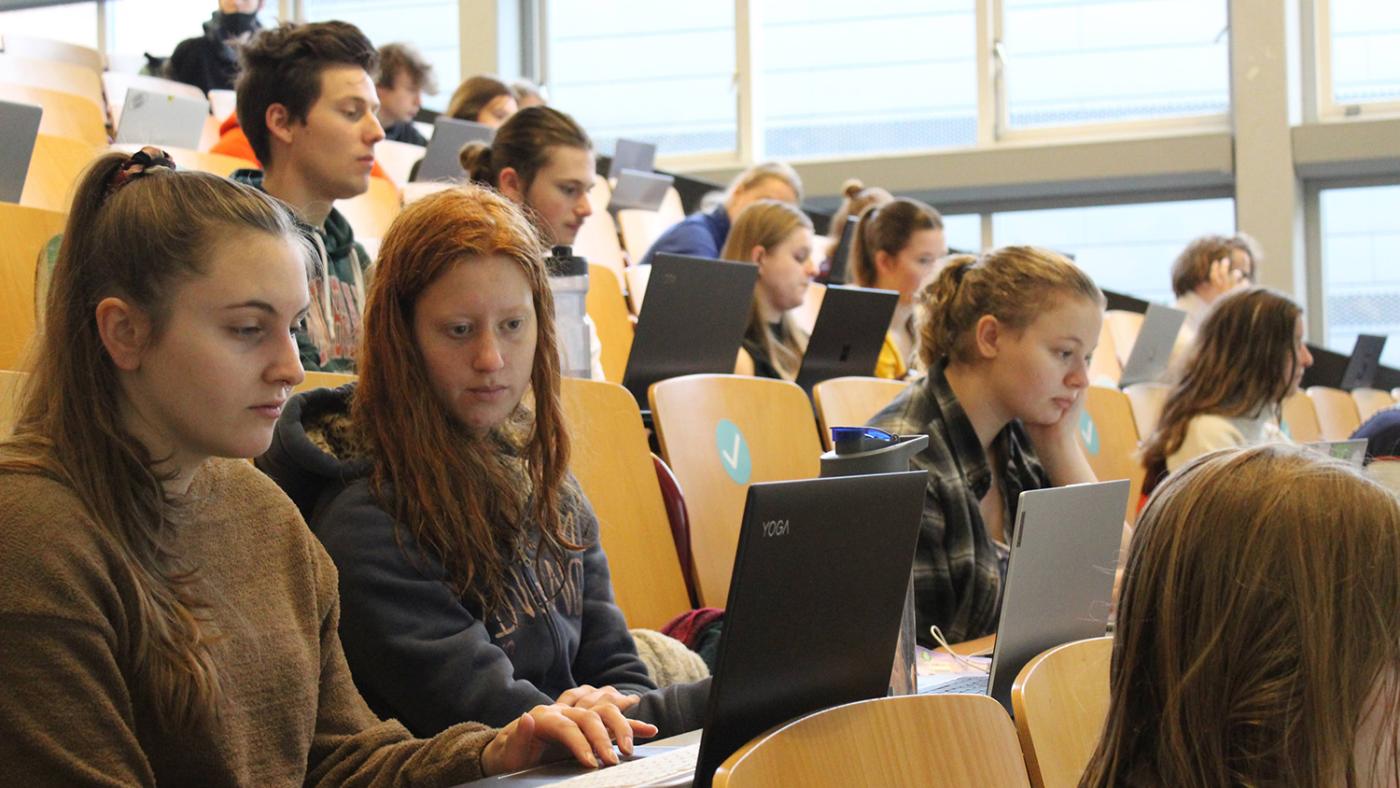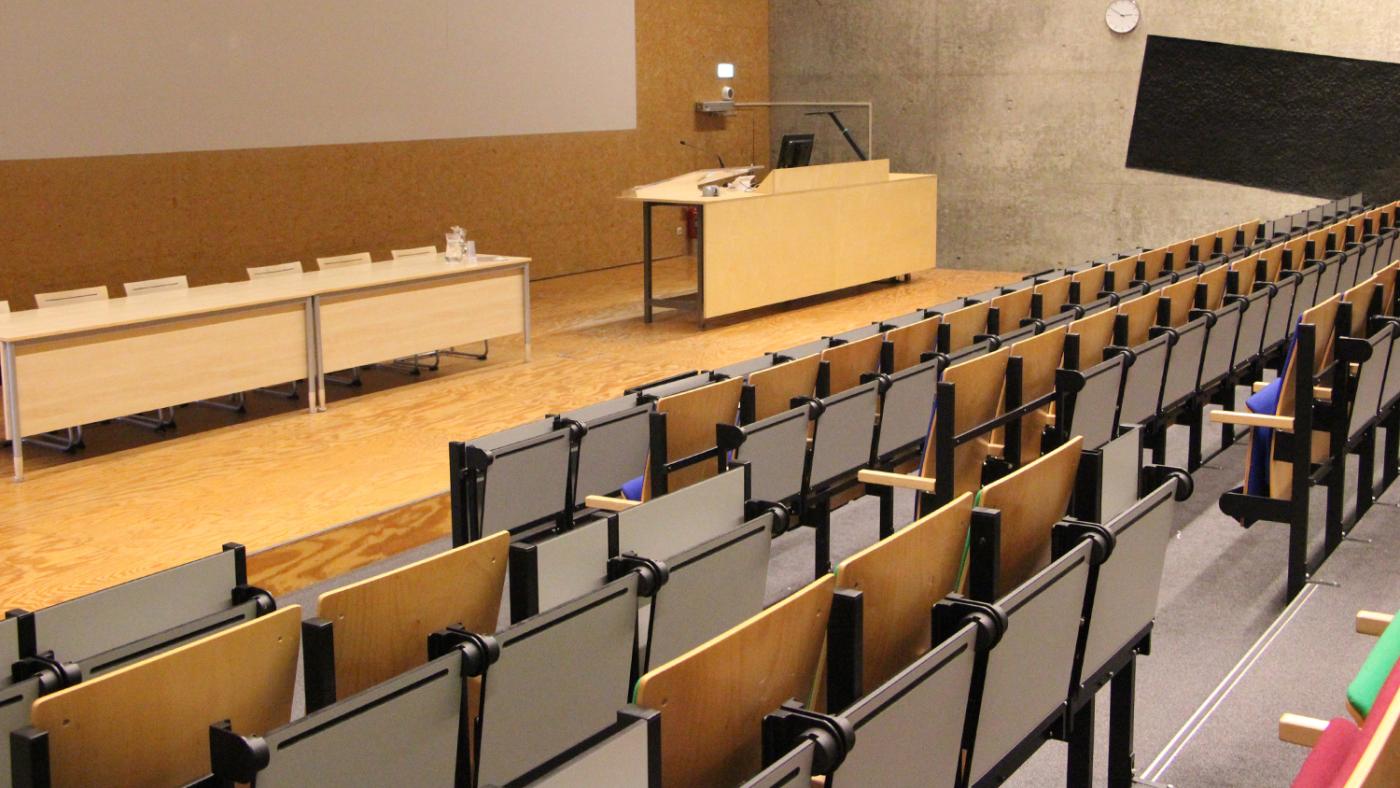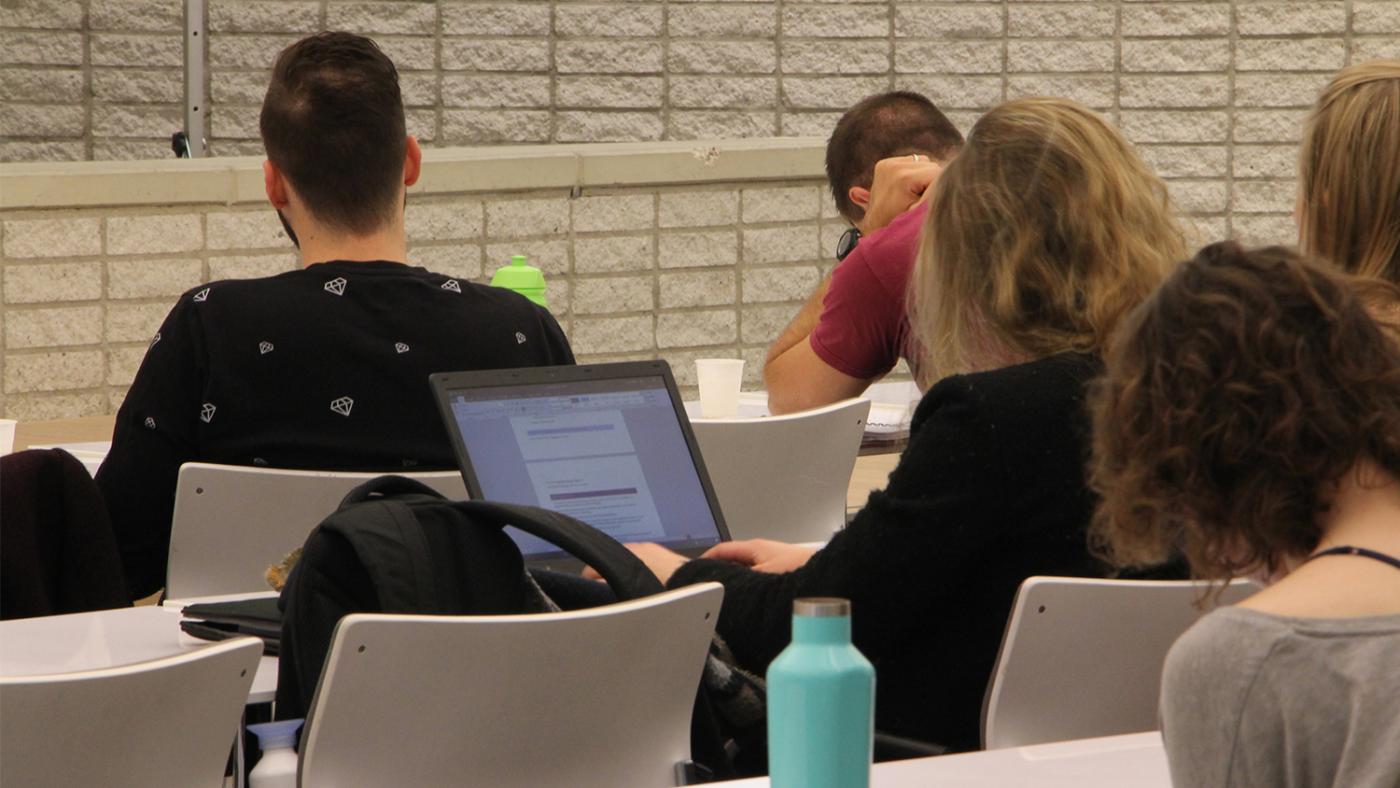Better scheduling aims to prevent empty lecture halls
‘There is no shortage of rooms, even with an increased number of students’

Is or isn’t there a glaring shortage of educational spaces at Utrecht University? It seemed that way these past years. The university rented rooms at the Bolognalaan, barracks were quickly constructed at the Padualaan, several floors were rented at the Daltonlaan 500 and 700 and were rooms added at the International Campus. Several classes had to be taught online.
It was a combination of circumstances, according to the most recent memo (only with solis-id, ed.) about housing of education at the UU: increased student numbers, renovations, and scheduling issues. Now, new construction and renting temporary rooms is no longer needed, the university says. They are investing in a new scheduling system. Moreover, more classes will be taught in the evenings, and on less busy moments of the week.
Empty rooms
Twice a year, for two weeks, the university checks each timeslot to see whether educational rooms are in use. If the answer is yes, the question is: are they also used for the type of education the space is meant for?
Compare that information to the schedule of reserved rooms, and you gain insight into – among other things – the number of rooms that aren’t actually used in the end. That can have several causes. Perhaps fewer students ended up enrolling in a course, which meant merging groups was a logical step, or the meeting was cancelled, for instance due to a lecturer’s illness.
In the first semester of the 2021-2022 academic year, one in five reserved classrooms ended up unused, according to the data added to the memo about housing of education. In the second semester, that number was as high as one in four. That’s a total of over 1,600 moments in which the classrooms could’ve been used for education.
Those classrooms are needed because the UU has to house more and more students: while during the 2019-2020 academic year, the UU had a little over 33,000 students (only with Solis-id, ed.), there were more than 39.000 three years later.

The Executive Board has announced it will not be constructing new buildings: all students should find a place in the currently available space. For that reason, the university will start a multi-year programme in educational planning, to achieve better scheduling, and balance supply and demand better: the available spaces and the educational activities.
Peak moments
The university is investigating whether or not scheduled spaces are being used, but will also look at the scheduling of rooms and buildings in general. The so-called occupancy rate of rooms will show how often, and at what times, these rooms are scheduled.
That mainly shows that there is an issue with peak moments: moments during the day, week, or year when the rooms and buildings are almost fully booked. In the first term, that’s mainly Tuesdays and Thursdays, especially between 10 am and 3 pm. “At those times, it’s almost always fully booked, but the Monday is pretty busy as well,” says Willemijn Maes, who works at the Facilities Service Centre (FSC), and analyses the use of classrooms.
The second semester is less busy, because students do internships, fieldwork, or are writing their theses, adds head of Student Affairs Marieke de Bakker, who’s leading this project.
Would it be better if students started their internships at the beginning of the academic year? “It’s possible, but that’s something that has to be decided within a programme. As for distributing the classes throughout the days or week, yes, we can work on that to give all educational activities their space. If you look at the data, it’s hard to keep insisting that we need to rent external rooms or construct more buildings.”
Not a shortage
The fact that the university wants a better distribution of classes, doesn’t mean that suddenly, a lot more classes will be scheduled on Friday or Wednesday afternoons. It’s for many employees their day off. “You can’t just start filling those times. There’s a whole world behind it,” says Jan-Willem Moerkerk, strategic housing advisor for Corporate Real Estate & Campus.
Moerkerk says “there is no true shortage of classrooms, even with the current increase in student numbers”. Especially given the fact that the university has “added a lot of educational spaces” last year. Among other things, it rented out rooms at the Daltonlaan 500, and added rooms at the International Campus.
The UU also rented a number of temporary educational spaces last year, to accommodate renovations. These are the rooms at the Bolognalaan, Padualaan, and Daltonlaan 700. These will not be in use after the summer holidays.
Complex puzzle
It’s a complex puzzle to schedule classes and practical sessions. It requires an accurate coordination between the lecturer’s availability, students, and educational spaces. The first preliminary schedules are made six months in advance.

“The prognoses of student numbers play an important role. That’s difficult to estimate. For example, we really only have somewhat of an idea of how many first-year students will come after we’ve had the matching days,” says De Bakker. “And due to the freedom of choice students have, it takes quite a while before we know more about which courses students will take. That makes planning a real challenge.”
This means principle and reality can vary widely: for instance when fewer students have signed up for a course, or students drop out during a course. That means faculties might be assigned more spaces than they end up needing, or lecturers request a large lecture hall to be sure, because at the time of requesting the room, they aren’t yet sure how many students will participate.
Fully booked
Due to the complicated scheduling process, it’s not possible to fully book all the available spaces. At some moments, for instance, there is no possible match between lecturer, student, and space.
That’s why there’s an agreement that an average occupancy of 70 percent is the standard for reserving educational rooms, and is regarded as a full occupancy of 100 percent.
Space left
All faculties are divided into three clusters, so-called contingents, who divide their educational spaces amongst themselves. These are the city centre, the Sciences, Social Sciences, and Geosciences faculties (so-called ‘BGS’), and Veterinary Medicine. The occupancy rate of each contingent is registered per term and per half-day: either between 9 am and 5 pm, or between 5 pm and 7 pm.
“There’s a lot of demand for spaces in the city centre this academic year,” Moerkerk says. During the first term, the city centre was occupied above the standard. This reduces somewhat in the rest of the year. “That’s not an issue if lecturer, student, and room are available at the same time.”

In the contingent of Sciences, Social Sciences and Geosciences, the educational rooms in the first and second term are almost at the occupancy standard. In the third and fourth terms, occupancy drops below the standards. Veterinary medicine is (far) below the standard throughout the year.
The occupancy rates of lecture halls and work group spaces of all faculties taken together are also known. Especially in the first term, the lecture halls are fully booked during the day. By the fourth term, the rooms are booked far below the occupancy standard. For work group rooms, this is true throughout the year.
Evening classes
The occupancy of classrooms during the day differs greatly from that in the evenings, says Marieke de Bakker. Far fewer classes are scheduled in the evenings. The university, by the way, does not talk about ‘evening classes’; the working hours of the UU are from 9 am to 7 pm, which includes classes.
The evening timeslots are never fully booked. At BGS, this is only 14 percent in the first term. In the city centre, evening classes are a bit more common: a little over half of available timeslots are booked.
According to the Bakker, a little more evening classes would relieve the pressure on the system during the day. “There are some exaggerated stories making the rounds, as though we’re going to solve the perceived shortage of rooms – meaning the peak hours on certain days and times – by scheduling large numbers of classes in the evenings. That isn’t true. With a little bit of improvement in the distribution, including during the day and throughout the week, we’ll be in a much better place.”
The work group Education Logistics has at some point made a tentative calculation of how many classes should take place in the evenings. De Bakker says: “With ten percent more scheduling in the evenings, we’d probably be relieved of our bottlenecks.” “It’s only just one timeslot, whereas we have four during the day. If you look at that ratio, it doesn’t have to be much,” Willemijn Maes adds.
More than needed
The goal, then, is a better distribution in the schedule, but the additional issue is that some of the scheduled rooms end up unused. There probably won’t be a solution for that in the near future.
“Refining the data” and “more calculation models” should help, according to De Bakker. “There are good reasons why lecturers ask for a little more than they think they need. It isn’t an issue of ill will. They know that later on during the scheduling process, it’s harder to get additional rooms.”
But there is no clear view on the reasons why lecturers don’t use the rooms they reserve. “That’s why we’re going to start the Education Planning programme, to figure that out and talk about it with each other.”